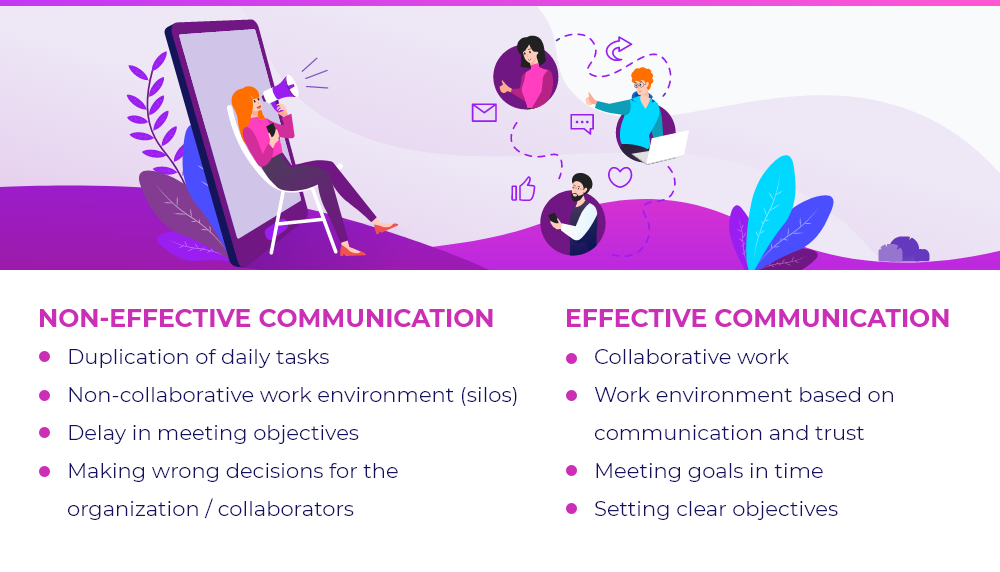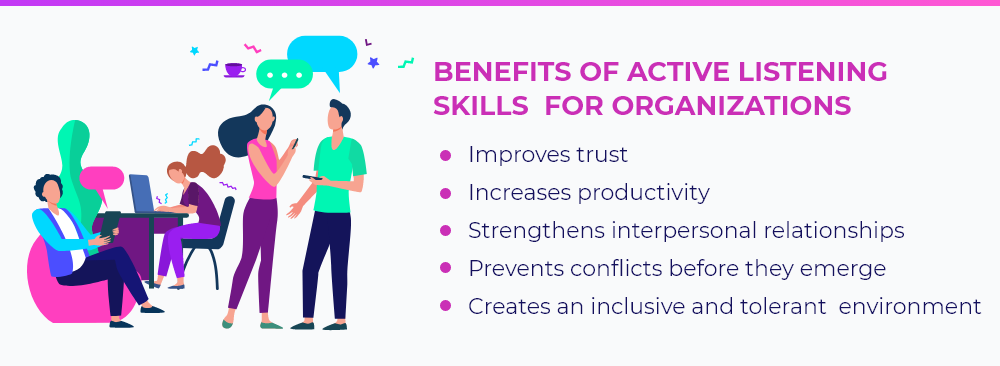3 keys to develop effective communication skills in your organization
Have you ever ended a meeting feeling you didn’t quite understand what was discussed during it? Ever sent an email to your team and then received replies asking questions to clarify the importance of your message? Effective communication skills are difficult to learn because communication itself is one of the most complex activities people carry out, and very often, “short-circuits” come about when companies try to improve their communication skills.
What does effective communication skills imply? To start with, it goes far beyond the mere exchange of information. So, first you should make sure you are aware of what the intention of the message is and then, communicate it successfully. Effective communication strategies at work are those which succeed at making the target audience understand why the message received is important.

However, this certainly isn’t something easy to achieve, since, as Stephen Convey once said, “the biggest communication problem is we do not listen to understand, we listen to reply”. This means to say that communicating effectively has a key component: In the first place, whoever is communicating must show true interest and active listening towards the target audience we aim to interpellate.
The impact of effective communication in companies
A successful communication is one of the not-so-secret ingredients behind the operation, development and progress of companies. More than 70% of employees feel committed to their organization when it communicates crucial information, such as company objectives and individual / organizational results, in a clear and effective way.
Here are some examples of non-effective and effective communication.

Conversely, poor communication can have a drastic negative impact on your business, leading to unwanted results such as delay or inability to complete projects, low morale, increased stress, unfinished goals, and up to thousands of dollars in lost sales.
Listen first, speak last
Active listening definition is simple: It means being present and receptive to what’s going on with those involved in the conversation, and that’s essential to improve the way we communicate. It implies recalling what the other person says, keeping in mind who they are, having insight on their personal and work history, and providing answers according to what they point out to us and how they do so. It all comes down to paying attention to both the other person’s speech and their body language.

Active listening takes into account the emotional and psychological components involved in communication and, thus, helps us to show our teams that they are listened to, valued and understood.
Active listening skills you can put into practice today:
- Avoid giving unsolicited advice.
- Try not to judge the other when they talk.
- Paraphrase what was said to check understanding.
- Pay attention to details.
3 keys to promote active listening and communicate effectively
1.Make room for empathy: Empathy is a word that has been in vogue for a while. However, for the past months, it has shown to be especially necessary within companies to ensure employees’ well-being. Actually, a recent study indicates that during 2020 more than three out of four employees (78%) believed that it was important for their leader to be empathetic and to understand their needs.
Empathy allows us to establish human connections beyond our work roles, which is vital to genuinely understand what others think, believe and feel, and take action according to their needs.

Here are some empathic active listening examples you can put into practice right away:
- Keep an open mind.
- Pay full and true attention to the person you are talking to.
- Listen carefully – distinguish feelings from data in their words.
- Show you’re receptive with both your verbal and body language.
- Follow up on that which is necessary.
2.Focus on clarity: Usually, the cause of unsuccessful communication in companies is poor clarity in the message conveyed. Truth is, either due to misunderstandings, lack of accuracy, or because we didn’t ask the right questions, not being clear enough when communicating can lead to consequences such as demotivation, execution mistakes and frustration.
Additionally, as the trend of hybrid work models will continue during 2021, clarity will be a key ally for companies that seek to communicate with transparency and increase the trust of their employees – especially in a context where the return to face-to-face work from office remains uncertain.
Some ideas to improve the clarity of your messages:
- Think about what you want to communicate first: Take into account who you are addressing, what the best communication channel is, and only then, begin to think about the structure of your message.
- Be specific: Set deadlines, include dates, provide as much detail as necessary to make sure there can be no misunderstandings.
- Keep everyone on the same page: Make room for daily meetings to check your teams understand what’s being discussed. Plus, make it clear your door is always open to those who have questions or concerns.
3.Use technology to create a work environment that enhances collaboration, transparency and trust: The experience during last year has shown us that technology can be a key tool to keep us informed. Slack, Google Meets, Microsoft Teams and many other tools, are already part of daily interactions around companies, as they help us to connect with our colleagues more fluently. However, to improve communication, companies need to take a step further and make use of technologies that allow them not only to provide information, but also to generate a much more connected and transparent organization. Let’s take StarMeUp, for example, a recognition platform that allows us to celebrate everyday events, linking them with the values of the company. This solution helps us communicate key messages such as organizational goals, provide clarity on how they connect to personal objectives, track them as they are carried out, and publicly celebrate when they are accomplished. In this way the organizational culture is strengthened, increasing the results of the company.
Ready to put our tips into practice?
Communication is the keystone of business success. Depending on how it’s carried out, it can positively or negatively affect employees’ performance and impact the overall productivity of the company. Beyond personal, organizational and contextual challenges, effective communication is possible as long as we put our teams at the center of our attention.
By working on our emotional intelligence – combining active, empathic and clear listening with technology that encourages collaboration and transparency – we can significantly improve the relationship between employees, promote commitment towards our companies, and increase their levels of satisfaction and sense of belonging. Above all, communication is what ensures the well-being of everyone in the organization.